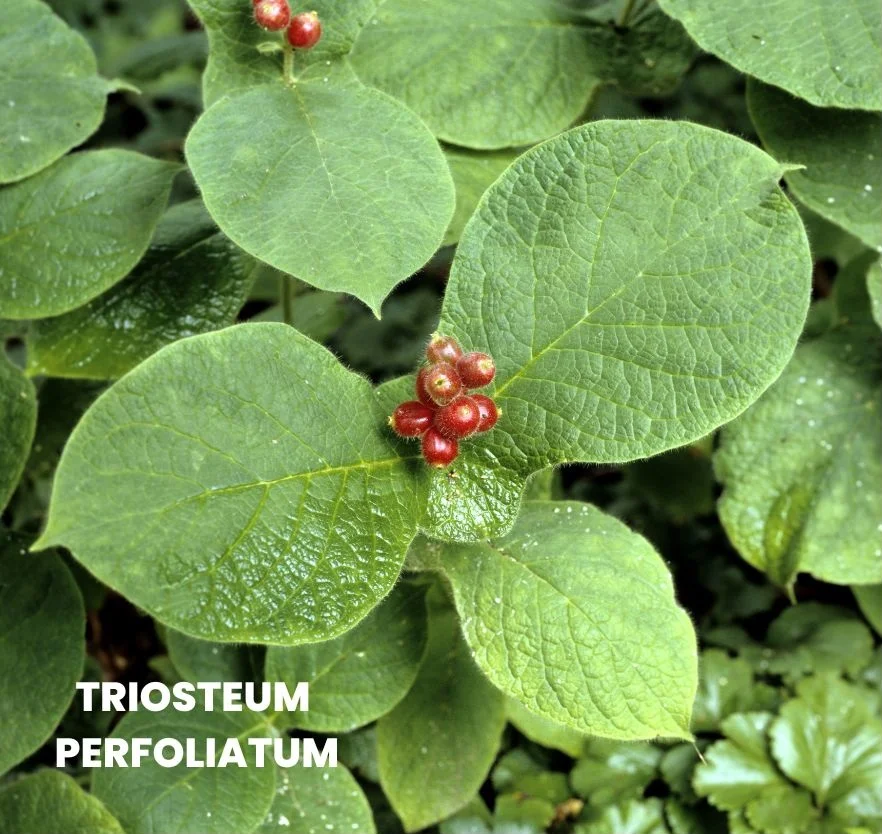Triosteum Perfoliatum, commonly known as Fever-root, is a homeopathic remedy derived from the plant of the same name, belonging to the honeysuckle family.
It is known for its use in treating gastrointestinal disturbances, fevers, and influenza.
It was traditionally employed by Native Americans and early settlers for its emetic and laxative properties, often used to manage colds, fevers, and digestive issues.

Table of Contents
ToggleSOURCE INFORMATION
Scientific Classification
- Kingdom: Plantae
- Order: Dipsacales
- Family: Caprifoliaceae (Honeysuckle family)
- Genus: Triosteum
- Species: T. perfoliatum
Origin and Historical Facts
- Triosteum Perfoliatum is native to North America, primarily found in the eastern regions.
- The plant grows in woodlands and on hillsides, and its berries, roots, and stems were historically used in folk medicine.
- The root was commonly used to induce vomiting (emetic) and relieve constipation (laxative).
- Homeopathically, its usage was formalized for treating fever-related symptoms, gastrointestinal complaints, and joint pain.
DRUG PATHOGENESIS
- Triosteum Perfoliatum works by stimulating the body’s natural healing mechanisms, particularly in cases of digestive disorders and fever.
- It is particularly suited for people suffering from diarrhea, nausea, and colicky pains.
- The remedy’s action extends to the nervous system, calming nervous irritability and reducing restlessness, especially in flu-like conditions.
PHYSICAL CONSTITUTION AND DIATHESIS
- This remedy is best suited for individuals with a tendency toward biliousness, meaning they often suffer from indigestion, bile disorders, or liver congestion.
- The person may be nervous, irritable, and restless, especially when dealing with fever or digestive problems.
- These individuals often have cold sensitivity and experience stiffness in their joints and muscles.
WHAT IS CONSTITUTION IN HOMOEOPATHY?
WHAT IS DIATHESIS IN HOMOEOPATHY?
TEMPERAMENT
- The temperament of a person suited for Triosteum Perfoliatum tends to be nervous and restless, with a disposition that worsens during fevers or gastrointestinal upset.
- They may become anxious or irritable when sick, with a tendency toward physical exhaustion during illness.
WHAT ARE TEMPERAMENTS IN HOMOEOPATHY?
KEY CHARACTERISTICS
- Diarrhea with colicky pains and nausea.
- Numbness of lower limbs after passing stool.
- Increased urine flow, especially during fever or digestive upsets.
- Relief of nervous symptoms, particularly during fever or influenza.
- Stiffness in joints, especially after illness.
- Occipital headaches with nausea, often followed by vomiting.
DETAILED ORGAN SYMPTOMS
HEAD
- Occipital pain (back of the head), worsened by rising from bed.
- Nausea and vomiting, commonly following headaches.
- Frontal headaches, especially during influenza.
STOMACH
- Loathing of food with an inability to eat due to nausea.
- Vomiting often occurs after nausea or when rising in the morning.
- Cramps and watery, frothy stools.
EXTREMITIES
- Numbness of the calves after passing stool.
- Stiffness of the joints, especially after fever or illness.
- Aching pains in bones and limbs, commonly seen in rheumatic conditions.
SKIN
- Itching welts and urticaria (hives) caused by digestive disturbances.
MODALITIES
- Worse: In the morning (nausea, vomiting), during influenza, and when rising from a lying position.
- Better: Lying down or resting.
WHAT ARE MODALITIES IN HOMOEOPATHY?
RELATIONSHIP WITH OTHER DRUGS
- Complementary remedies: Coffea and Hyoscyamus, which also help calm nervous symptoms.
- Compare with: Ipecac for nausea and vomiting, and Bryonia for joint pains aggravated by movement.
DOSE
- Triosteum Perfoliatum is generally used in the sixth potency (6th potency).
- Dosage depends on the severity of symptoms and should be repeated until improvement is noticed.
Frequently Asked Questions
What is Triosteum Perfoliatum used for?
- It is primarily used for diarrhea with colicky pains, nausea, and joint stiffness. It is also effective in influenza and biliousness.
How should Triosteum Perfoliatum be taken?
- The remedy is usually prescribed in the 6th potency, and the dosage is adjusted according to the patient’s symptoms.
Are there any side effects?
- When used in homeopathic doses, there are no known side effects. However, higher doses of the crude herb can cause vomiting and severe diarrhea.
Is it safe for children?
- Yes, it can be safely administered to children, especially for diarrhea and nervous irritability, but it is always advisable to consult a homeopath before administering it to children.
Meaning of Difficult Words
- Colicky: Relating to or suffering from severe abdominal pain.
- Biliousness: A condition related to excess bile, leading to digestive disturbances.
- Ozaena: A chronic nasal condition with a foul-smelling discharge.
- Urticaria: A skin condition characterized by itchy welts, commonly known as hives.
- Numbness: A loss of sensation or feeling in a part of the body.
- Occipital: Referring to the back of the head.
